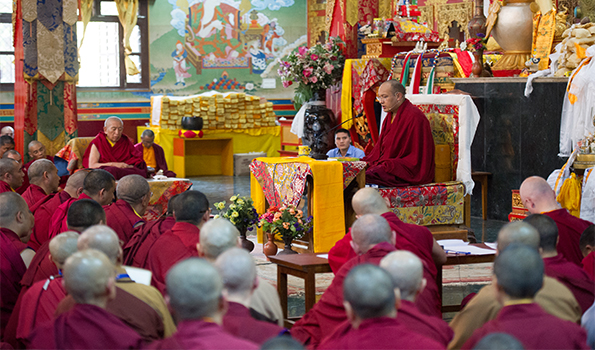
6 March 2014 – Vajra Vidya Monastery, Sarnath
In the fresh warmth of an early spring afternoon, just a few days into the Tibetan new year, more than five hundred people crowded into the Vajra Vidya Monastery shrine room eager to hear the Gyalwang Karmapa’s words of wisdom.
For days many had dotted the lawns of the monastery, sitting outside on the grass catching rays of the spring sunshine, hoping that the teachings would take place. When they finally joined the long queues to enter the shrine hall many wore broad smiles on their faces, a joyful atmosphere palpable among the crowd.
Although he had originally been scheduled to give three days of spring teachings, as he is currently recovering from a minor illness the Gyalwang Karmapa decided to teach for a single session only.
“Because of the difficulty with my health,” he explained, after reciting the opening prayers, “at first I thought that we’d have to cancel the entire spring teaching. But when I came down to the shrine room for a few moments on the first day of Losar I saw that many people had come here from all over the world. I thought that it would be better to teach at least one of the three days.”
The teaching took place in Sarnath, very close to the sacred site of Deer Park, which marks the exact spot where Shakyamuni Buddha gave the very first sermon to the first five disciples nearly 2600 years ago. To the delight of those gathered, the Gyalwang Karmapa once more turned the wheel of dharma in this holy land, teaching on a text by the glorious master Atisha. Called Essential Mind Training, the text contains many of the most important instructions of the Kadampa masters.
The Gyalwang Karmapa began by pointing out that despite the many different divisions and classifications of the dharma, in actuality all of the teachings come down to the same essential point: taming our own minds.
“The dharma must work as an antidote to the afflictions,” he said. “It must help us to reduce and pacify them.”
He turned to one of Atisha’s instructions in the text, which reads: The best spiritual teacher is to challenge your weaknesses.
“These weaknesses are our hidden faults,” he explained. “It’s not alright to just let them be—we need to point them out directly and challenge them.”
“Out of all the many instructions,” the Gyalwang Karmapa continued, “the most beneficial is to recognize what our own faults and weaknesses are. We may have some sort of fault or shortcoming within ourselves and not understand it. If we don’t realize that it’s a shortcoming, or haven’t really realized how bad it is, we will never actually improve in that area.”
He then illustrated this point by explaining that in Tibet there was a custom of thinking that when the lama criticized a student, they were actually being very compassionate and taking good care of that student.
“The connection between the lama and the student should be one where neither holds back anything from each other. This means the lama needs to point out the difficulties, shortcomings and faults of the student, and the student also needs to be direct and forthright about saying what afflictions are occurring in their mind.”
“Only when neither is holding anything back or hiding anything can we say it’s a good connection.”
He turned to another of the text’s instructions, reading: The best motivating factors are your enemies, obstacles, illnesses, and sufferings.
“When we really pursue the dharma with great faith and longing,” he said, “whatever difficulties or obstacles that we face will all become aids for us in achieving enlightenment.”
Returning to his own current situation, he observed wryly that it was actually he who had made himself sick. “During the Monlam, it’s not that I had so much work to do, but I rushed here and there and didn’t give myself enough time to rest. So my doctor and many of my acquaintances have all told me that I need to take rest.”
Those present—as well as the 1500 online viewers who tuned in to the live broadcast—were truly grateful to receive his teaching, even as they were united in the heartfelt aspiration that the Gyalwang Karmapa rests well and quickly recovers full health.
The spring teaching was also attended by the Gyalwang Karmapa’s main tutor, Khenchen Thrangu Rinpoche, who was seated on a throne to his left, and who is currently giving 10 days of annual teachings himself. As the spring teaching drew to a close, the Gyalwang Karmapa expressed how deeply happy he was that Khenchen Thrangu Rinpoche’s health had significantly improved over the past year, and how wonderful it was that his teachings were going very well.


